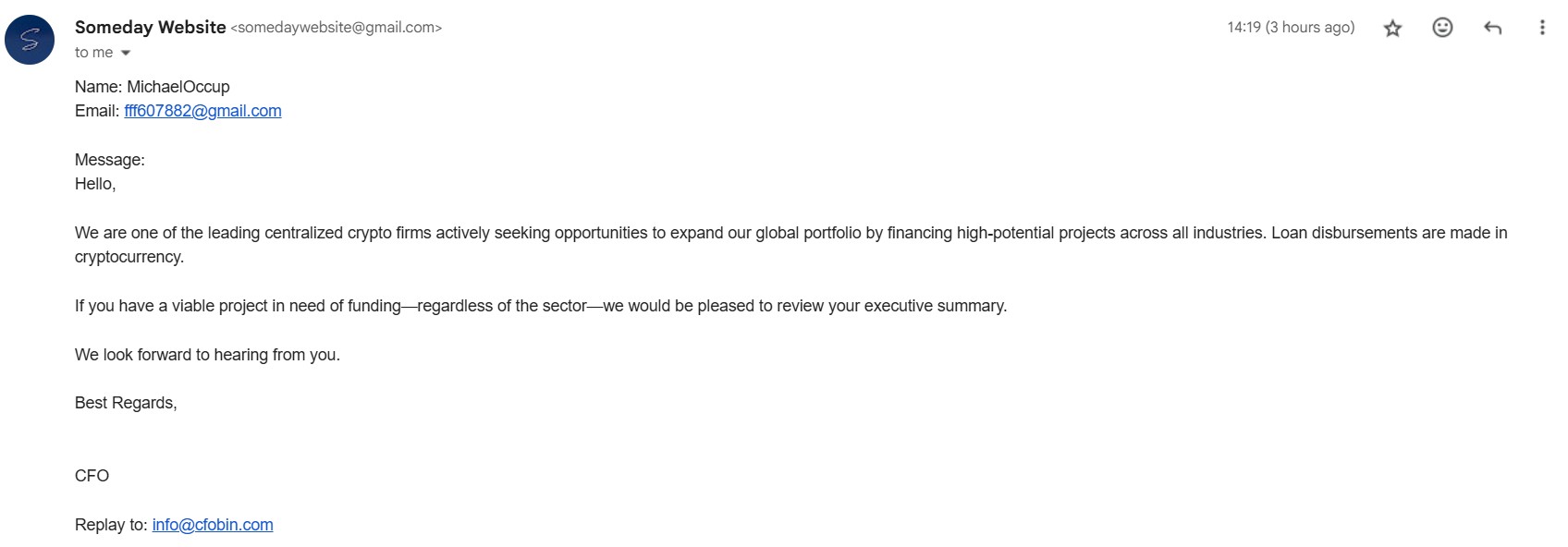Freelance Caution & Ethics
Anatomy of a Scam: The "We Want to Fund Your Project" Email
Published on August 28, 2025 by Joselito Bacolod
Hello, mga ka-dev at kapwa freelancers!
Sa journey natin, we are always hustling. We're not just building apps and websites; we're building our dreams. Kaya naman kapag may pumasok na email sa ating inbox that looks like a golden ticket— an offer to fund our dreams—it's genuinely exciting.
Just recently, I received one such email. An offer from a "leading crypto firm" looking to finance high-potential projects. At first glance, it's the kind of message that makes you stop and say, "Wow, finally!"
Pero bilang freelancers, one of the most important skills we need to master isn't just coding or design. It's the ability to spot a scam from a mile away. Let's dissect this email together, because it's a classic example of a trap we need to avoid.
Ito 'yung email:

Let's break down the warning signs, step-by-step:
Red Flag #1: The Unprofessional Sender
The very first thing I looked at was the sender's email address. Ang message ay galing daw sa isang "leading centralized crypto firm," pero ang email address ay fff607882@gmail.com.
Isipin mo na lang: a large, leading company using a random, disposable-looking Gmail account? That's the first and biggest red flag. Legitimate companies always communicate through their official domain.
Red Flag #2: The Vague and Impersonal Message
Notice the language. There's no company name. There's no name for the person who sent it (just "CFO"). Hindi ito naka-address sa akin personally ("to me"). This is a generic template designed to be mass-sent to thousands of people, hoping someone bites. A real investment inquiry would be specific, well-researched, and personalized.
Red Flag #3: The Mismatched Reply-To Address
This is a clever and common scam tactic. Ang email ay galing sa Gmail, pero ang "Reply to" field ay nakaturo sa info@cfobin.com. Ginagawa nila ito para makalusot sa mga spam filter. An email from Gmail has a much better chance of reaching your inbox than one from a new and suspicious domain. Kapag nag-reply ka, doon na papasok ang totoo nilang email server.
Red Flag #4: The "Too Good to Be True" Offer
At siyempre, ang pinaka-obvious na sign: an unsolicited offer of money. Legitimate investors and lenders don't just throw money at strangers over a cold email. They have processes, networks, and they do extensive due diligence. Kung may nag-aalok sa'yo ng loan nang hindi ka man lang nila kilala, it's almost 100% certain that it comes with a malicious catch.
So ano ba talaga ang habol nila? Simple lang: Advance-Fee Fraud.
Ganito ang laro niyan. Kapag nag-reply ka at nag-send ng "executive summary," mabilis nilang aaprubahan ang project mo. Sasabihin nilang "impressed" sila at handa na silang i-release ang funds. Pero may isang catch. Bago makuha ang "loan," kailangan mo munang magbayad ng "processing fee," "legal fee," o "insurance fee." Hihingin nila ito sa cryptocurrency, because it's fast, untraceable, and irreversible.
Once you send that fee, they will vanish. Mawawala na sila na parang bula, kasama ang pera mo. You will never get the loan, at wala ka nang habol.
As freelancers, we are the CEOs of our own careers. We have the responsibility to protect our time, money, and intellectual property. While we should always be open to opportunities, we must also be fiercely protective of our own safety.
Always scrutinize unsolicited offers. Always verify the identity of the people you're talking to. And remember the oldest rule in the book: if it seems too good to be true, it almost certainly is.
Keep building but always stay vigilant.